>10 Tips For Cleaning Your Car Like a Pro <
#1
10 Tips For Cleaning Your Car Like a Pro
MCF Member's, let us know if this post was helpful...
Post your tips/links to this thread `OK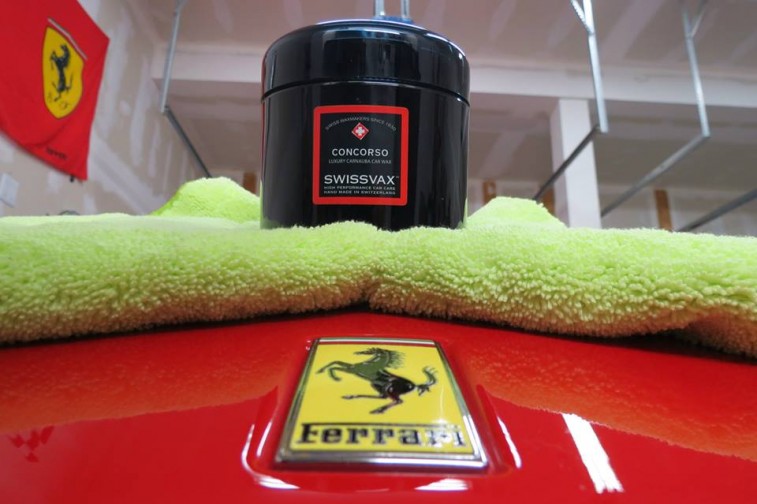 Source: Michael Trevor
Source: Michael Trevor
Michael Trevor is a staple in the Cincinnati automotive scene. He is a man who knows damn near everyone, and has quite the reputation as being one of the area’s most knowledgeable luxury and exotic specialists.
Trevor is the gentleman who put me in touch with James Glickenhaus for an interview right before Glickenhaus’s SCG-003 set a new world record at the Nürburgring, and was a judge at this year’s Ault Park Concourse d’Elegance. But Trevor doesn’t just surround himself with the world’s most expensive and gorgeous cars because he wants to — he does it because he has chosen to confront their ugly sides in the hopes of making them beautiful once more.
With almost two decades of experience, Trevor has fashioned himself into one of America’s most sought-out premier auto detailers. In that time, he has been tasked with detailing some of the most opulent and over-the-top cars available to the American market, and in return he has created quite the name for himself.
With an ever-growing clientele list that spreads from Florida to the farthest Eastern seaboard, Trevor never finds himself short on work, and clients will find that he usually has quite the wait list, since such an attention to detail requires both time and patience.
Trevor offers awide range of detailing services, and does not shy away from tougher jobs like paint and carbon fiber finish correction, wet sanding, or reconditioning. Applying hydrophobic layers and scratch-resistant protective coatings are staples in his everyday business, and interior shampooing sits right alongside leather cleaning, conditioning, and repair.
Using the latest tools and techniques also helps give Trevor the upper hand as he continues to offer his clients the most thorough and professional detailing services money can buy.
So with beautiful driving weather blanketing the American landscape, I opted to reach out to Trevor in the hopes of seeing if he had any tips on how the rest of us might be able to do away with all of the road grime, salt, and scratches that winter leaves in its wake.
There are many different ways of cleaning one’s car, and Trevor has graciously taken the time to show us how to do it properly so that we don’t damage our vehicles in the process. So here are a few of his favorite quick tips so that the next time it is time to clean your car, you will be able to save time because you already know everything.
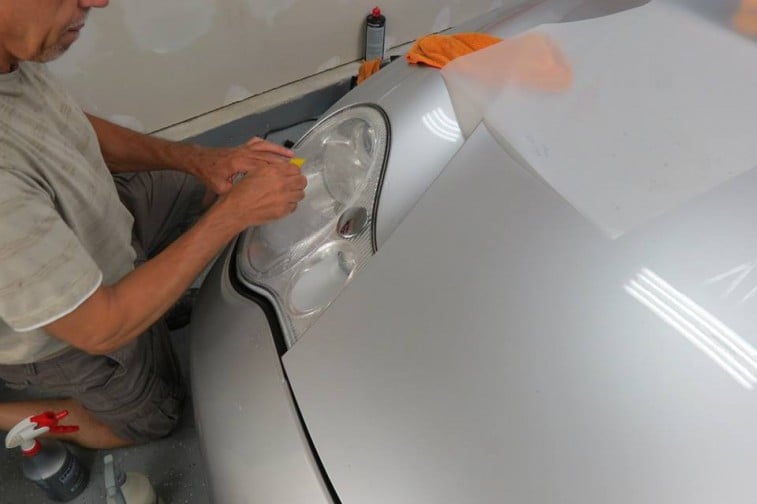 Source: Michael Trevor
Source: Michael Trevor
1. Why should I detail, and how often?
Detailing really is the first line of defense when it comes to protecting one’s car from the elements. Without regular cleaning, conditioning, and treatment, a car’s interior and exterior are prone to discoloration, marring, cracking, and peeling courtesy of UV damage, road debris, and every other manner of imaginable contaminant.
How often a car needs to be detailed is dependent primarily upon how often the vehicle is driven, the type of extreme driving conditions it sees (snow, hail, sandstorms, etc.), and if it spends long periods of time sitting in the sun.
Michael recommends a weekly wash to keep pollen and dirt from embedding itself in the clear coat, and a monthly wash and wax to ensure the shell of the car remains covered with a shiny shield. Sealants and coatings, on the other hand, are a procedure that is best left to the pros, and should be attended to every one to two years depending on the kind of driving the car is used for.
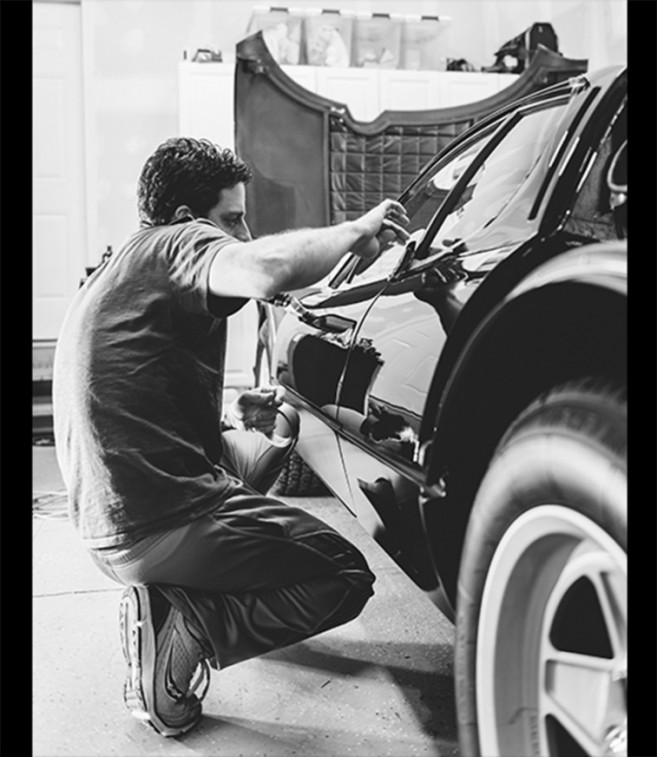 Source: Michael Trevor
Source: Michael Trevor
2. How do I assess what my car needs?
A good rule of thumb is that a car should be inspected once a week to see what level of care it might need. When looking at a car, it is best to always inspect the paint in either direct sunlight or under the glare of a bright light. This way, all of the swirl marks, scratches, and imperfections can come to the surface for analyzing. The more scratches and swirls it has, the longer it will take for the car to be returned to its original shine. Headlights should be inspected for hazing, scratches, and rock chips, while lower trim and splash guards need to be inspected for cracks, salt, and road grime build-up.
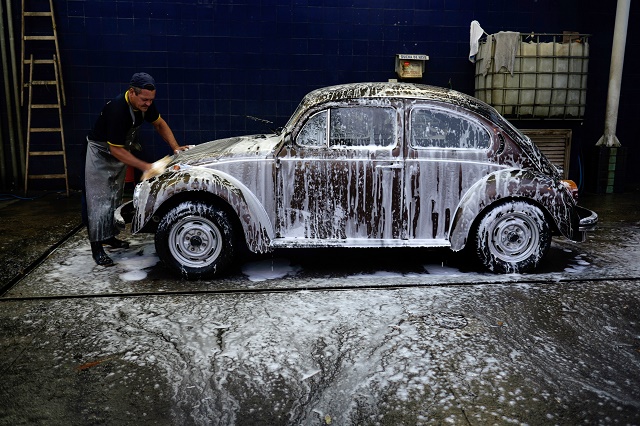 Yasuyoshi Chiba/AFP/Getty Images
Yasuyoshi Chiba/AFP/Getty Images
3. Am I washing my vehicle properly?
When washing a vehicle, it can be easy to ruin a perfectly corrected finish by not taking the proper steps to eliminate swirling and paint marring. Here are Michael’s three steps he uses when washing a car:
1. Make sure you use three buckets for the exterior of the vehicle and at least two different-colored wash mitts, along with a soft round brush with bristles approximately two inches in length, and a wooden or plastic handle with no metal components. One bucket should have an appropriate amount of car wash shampoo that is super soft, slick, and safe for all surfaces, while the other two should have plain H2O.
All three buckets should have at least one grit guard each, and should be labeled as buckets 1, 2, and 3. Bucket 3 should have your wash mitts, soapy water and a grit guard, while buckets 1 and 2 should just have the H2O and grit guards. Use one wash mitt starting at the centerline of the vehicle and slowly work your way down.
Make sure each time you use the wash mitt it is rinsed in bucket 1, then again in bucket 2, and then soak it in the soapy water in bucket 3 before bringing it back to your vehicle. Repeat the steps with your other, different-colored wash mitts for the lower portion of your vehicle and bumpers. Follow up in the hard-to-reach areas with the soft brush, such as bumper gaps, the fuel filler compartment, and other areas that a wash mitt can’t reach.
2. Rinse your vehicle thoroughly, ensuring you have removed all soap and dirt from the surface. To eliminate the chance of swirling and marring, dry your vehicle with an electric blower, similar to what you’d see at a hardware store, or use a Master Blaster (a high-powered blower designed for drying vehicles). To ensure the air coming out of the blower is clean, never use the blower for anything other than drying your vehicle(s).
3. Spray a light mist of spray sealant or spray wax on the vehicle surface and wipe clean with a soft, thick-ply microfiber for a scratch-free finish.
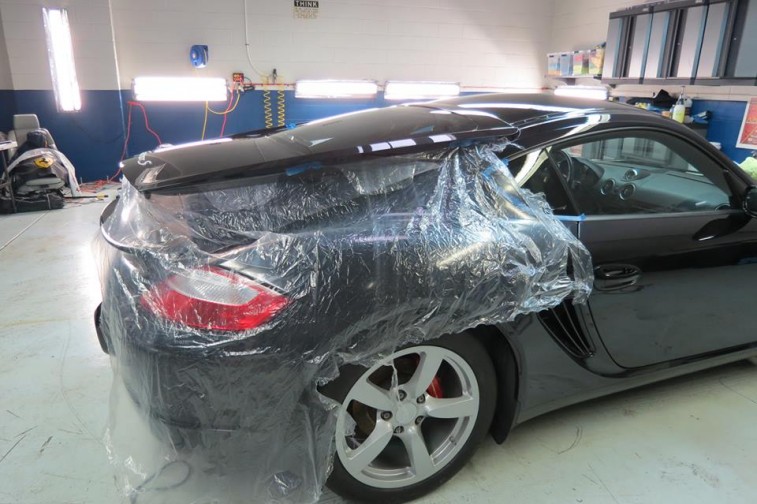 Source: Michael Trevor
Source: Michael Trevor
4. How do I prep my vehicle for polishing and/or a final protection step?
This crucial step usually involves the taping-off of key areas, covering glass with newspaper, and wrapping certain components like exhaust tips in plastic. It is important to make sure that every other step in the process has been completed at this point, and that the car is devoid of any form of grit or contaminant that might compromise the polishing process.
A great way to avoid scratching and marring is to apply a semi-permanent paint sealant. These sealants often take a day or two to cure, but once dried will last up to two years. This coating will adhere to the paint’s surface, and hydrophobic and semi-permanent scratch-resistant coatings are what Trevor recommends above all others.
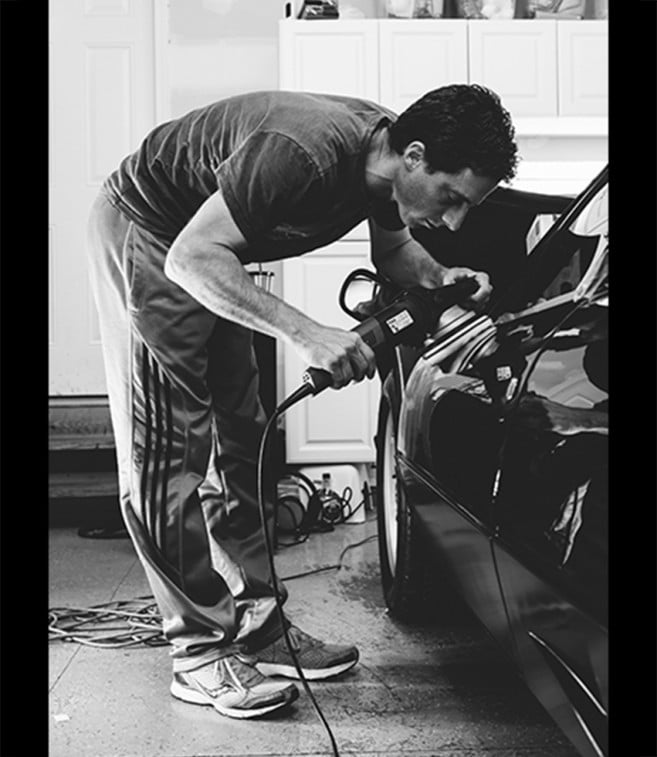 Source: Michael Trevor
Source: Michael Trevor
5. What is polishing? What does it do? How do I do it?
Polishing is the act of using a very soft polishing disc on an air or battery-powered tool to heat-up the clear coat so that it may be more evenly distributed across the car, thus filling in any scratches on the surface. Mild rubbing compounds can be utilized during this step, and care should be taken, as too much pressure will cause swirl marks and “burning” of the clearcoat.
The polishing process is a simple one in which the car is first washed, and before it dries completely, a detailer will apply an even coat of compound to one area of the car via the orbital disc. Long, slow movements with even pressure are key here, and once an area is taken care of, it is safe to move on to the next panel of the car. Just be sure that both the polishing pad and the car have a slight amount of water on them at all times to keep the paint protected. Once the entire vehicle is polished, rinse it off, toss on a coat of wax, and admire the results.
It is also good to occasionally rinse the polishing disc, as debris and polishing compound will sometimes build up on the pad. It is also important to be mindful of the fact that the outer areas of the disc spin quite a bit quicker than the inside, so be careful of those edges unless a damaged clear coat is on the agenda for the day! Polishing is not something Trevor recommends doing often, as it has the tendency to damage the clearcoat if done in excess.
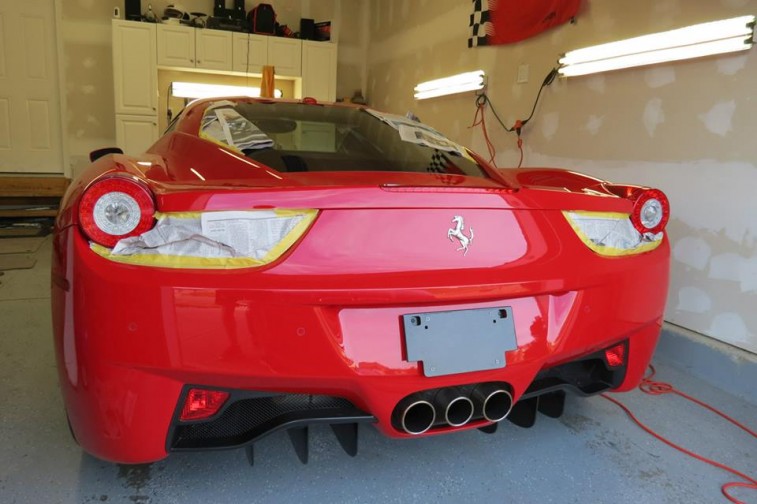 Source: Michael Trevor
Source: Michael Trevor
6. Do I wax, seal, or coat my vehicle, and what is the difference between the three?
The distinction between car wax and a sealant is that wax continues to be true to title and always contains some type of natural wax-like substance. A paint sealant on the other hand is always wax-free, and is usually made from synthetic compounds and contains polymers as a substitute for the wax.
A coat is a much harder and more permanent of a product, and it protects way more than wax or sealant combined since it’s typically resin or quartz-based. This harder and thicker layer of protection will often last a year or two, unlike waxes and sealants, which need to be redone every month or so. The choice is ultimately up to the car’s owner at the end of the day as to which approach he or she prefers, and even though it costs quite a bit more, a fresh coat on a car is the best way to go Trevor says.
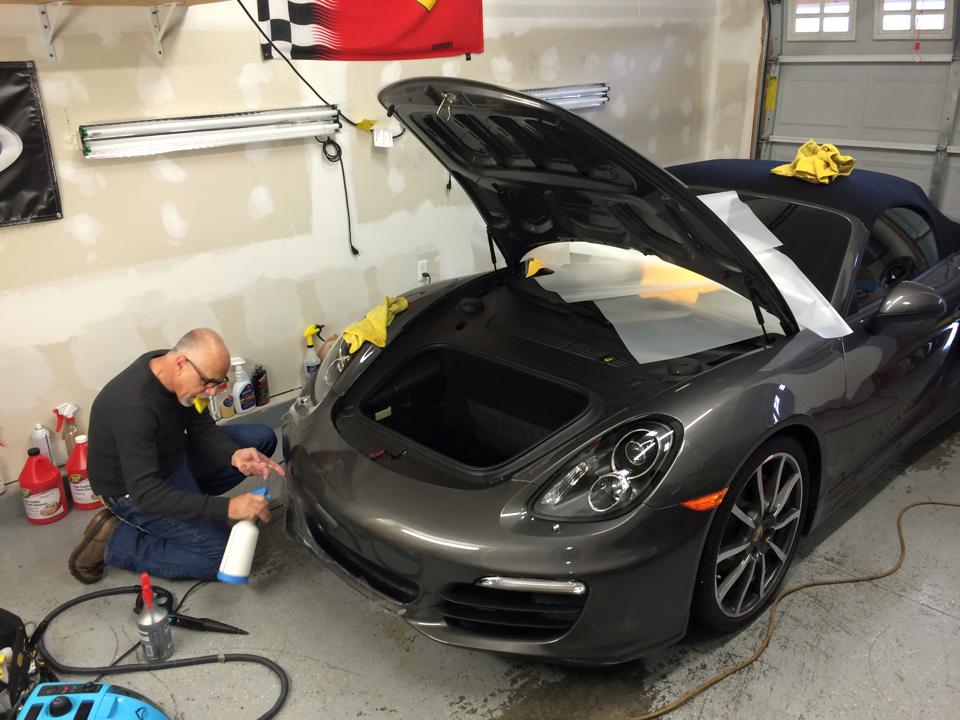 Source: Michael Trevor
Source: Michael Trevor
7. How do I maintain my vehicle’s finish between waxes, sealants, or coatings?
Proper regular cleaning, avoiding parking under trees that may drip sap onto a car, using quality cleaning products at the appropriate time, and knowing when to call up guys like Trevor for some advice are all important ways to stay on top of a car’s upkeep. A weekly wash that follows the procedures listed prior is a great place to start, and staying on top of monthly waxing/sealing will keep contaminants out of a car’s precious paint job.
Taking action as soon as a problem is detected is also an important step, as many contaminants like sap and bird droppings will become difficult to remove once they harden, which proves that preventative maintenance can be just as important as the detailing process itself.
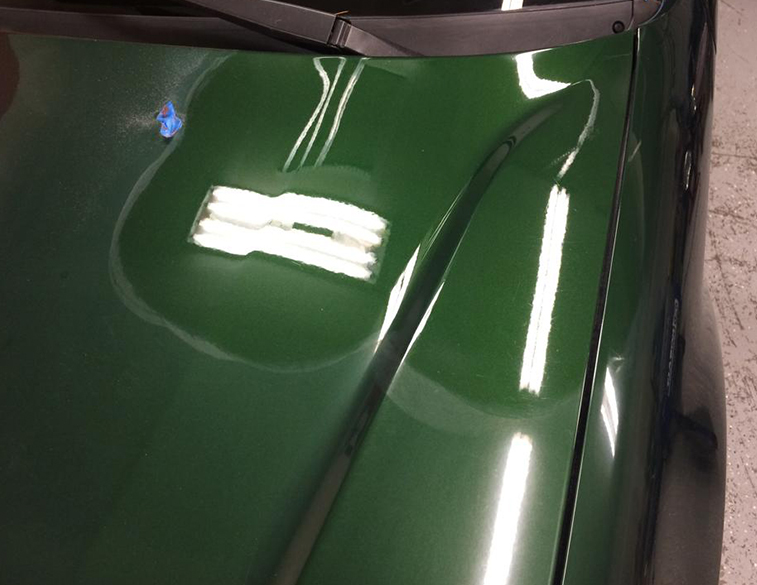 Source: Michael Trevor
Source: Michael Trevor
8. How do I get the most out of the detailing process?
To get the most out of the detailing process, Trevor recommends that a car’s owner keeps up with preventative maintenance, uses the appropriate products for cleaning, does research prior to jumping in head first, and knows when to hand over the car to a professional.
Trevor has seen a lot of damaged cars that went from filthy to marred because an owner decided to clean the car without going through the necessary paces. But people can still get the most out of the detailing process by merely taking their time, looking over a car closely, and knowing that it often takes a few tries before a car’s imperfections can be corrected appropriately.
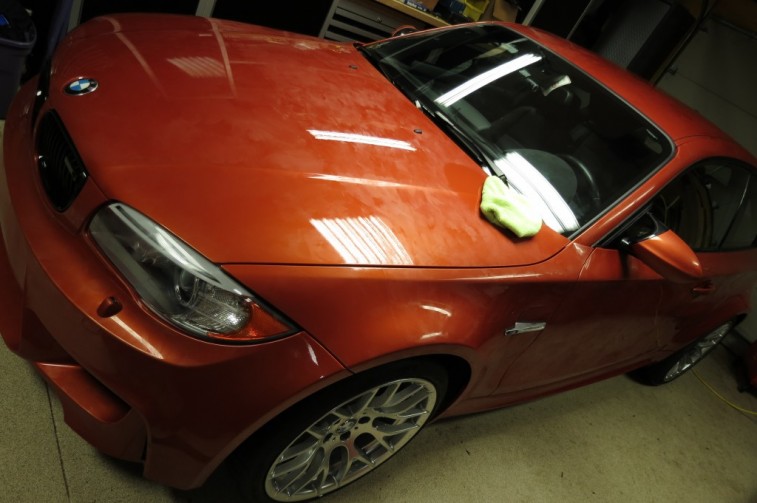 Source: Michael Trevor
Source: Michael Trevor
9. What are the benefits of properly caring for a vehicle’s finish?
A car’s finish is all that is protecting the paint from the elements, and if it breaks down, the car will fade in vibrancy and is then prone to permanent damage like rust. Most Americans sell or trade in their cars after a few years, so having a rich and well-protected exterior is a first sign to a buyer or dealer that this car has been well maintained, further boosting trade-in/resale values. The interior plays an equally crucial role as well, since no one is going to offer top dollar for a car with cracked leather seats, a sun-damaged dash, or a filthy floorboard.
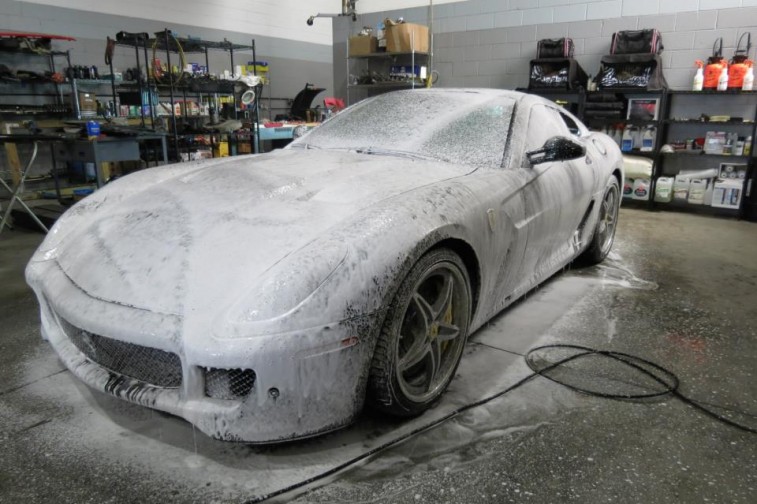 Source: Michael Trevor
Source: Michael Trevor
10. What can I do myself and what should be left to the professional?
Sometimes a job is just too big for the typical car owner, and it is time to hand off the keys to a professional detailer. The job could take too much time, require special tools that prove to be pricey, or it could be overly intimidating for someone who does nothing more than take their car to a drive-thru car wash on occasion.
Regardless of what the issue may be, there are trained detailers out there who are more than willing to undertake this tedious task for a healthy chunk of change. Will they all have the experience, insight, and professionalism as Trevor? Probably not. So be sure to look up reviews and see if any close friends or family members can recommend someone nearby, because a well-maintained car is a direct reflection of the person driving it.
OK, please post your thoughts/opinions/help > Your turn
MCF Member's, let us know if this post was helpful...

Post your tips/links to this thread `OK
- Micah Wright
- February 21, 2016
 Source: Michael Trevor
Source: Michael TrevorMichael Trevor is a staple in the Cincinnati automotive scene. He is a man who knows damn near everyone, and has quite the reputation as being one of the area’s most knowledgeable luxury and exotic specialists.
Trevor is the gentleman who put me in touch with James Glickenhaus for an interview right before Glickenhaus’s SCG-003 set a new world record at the Nürburgring, and was a judge at this year’s Ault Park Concourse d’Elegance. But Trevor doesn’t just surround himself with the world’s most expensive and gorgeous cars because he wants to — he does it because he has chosen to confront their ugly sides in the hopes of making them beautiful once more.
With almost two decades of experience, Trevor has fashioned himself into one of America’s most sought-out premier auto detailers. In that time, he has been tasked with detailing some of the most opulent and over-the-top cars available to the American market, and in return he has created quite the name for himself.
With an ever-growing clientele list that spreads from Florida to the farthest Eastern seaboard, Trevor never finds himself short on work, and clients will find that he usually has quite the wait list, since such an attention to detail requires both time and patience.
Trevor offers awide range of detailing services, and does not shy away from tougher jobs like paint and carbon fiber finish correction, wet sanding, or reconditioning. Applying hydrophobic layers and scratch-resistant protective coatings are staples in his everyday business, and interior shampooing sits right alongside leather cleaning, conditioning, and repair.
Using the latest tools and techniques also helps give Trevor the upper hand as he continues to offer his clients the most thorough and professional detailing services money can buy.
So with beautiful driving weather blanketing the American landscape, I opted to reach out to Trevor in the hopes of seeing if he had any tips on how the rest of us might be able to do away with all of the road grime, salt, and scratches that winter leaves in its wake.
There are many different ways of cleaning one’s car, and Trevor has graciously taken the time to show us how to do it properly so that we don’t damage our vehicles in the process. So here are a few of his favorite quick tips so that the next time it is time to clean your car, you will be able to save time because you already know everything.
 Source: Michael Trevor
Source: Michael Trevor1. Why should I detail, and how often?
Detailing really is the first line of defense when it comes to protecting one’s car from the elements. Without regular cleaning, conditioning, and treatment, a car’s interior and exterior are prone to discoloration, marring, cracking, and peeling courtesy of UV damage, road debris, and every other manner of imaginable contaminant.
How often a car needs to be detailed is dependent primarily upon how often the vehicle is driven, the type of extreme driving conditions it sees (snow, hail, sandstorms, etc.), and if it spends long periods of time sitting in the sun.
Michael recommends a weekly wash to keep pollen and dirt from embedding itself in the clear coat, and a monthly wash and wax to ensure the shell of the car remains covered with a shiny shield. Sealants and coatings, on the other hand, are a procedure that is best left to the pros, and should be attended to every one to two years depending on the kind of driving the car is used for.
 Source: Michael Trevor
Source: Michael Trevor2. How do I assess what my car needs?
A good rule of thumb is that a car should be inspected once a week to see what level of care it might need. When looking at a car, it is best to always inspect the paint in either direct sunlight or under the glare of a bright light. This way, all of the swirl marks, scratches, and imperfections can come to the surface for analyzing. The more scratches and swirls it has, the longer it will take for the car to be returned to its original shine. Headlights should be inspected for hazing, scratches, and rock chips, while lower trim and splash guards need to be inspected for cracks, salt, and road grime build-up.
 Yasuyoshi Chiba/AFP/Getty Images
Yasuyoshi Chiba/AFP/Getty Images3. Am I washing my vehicle properly?
When washing a vehicle, it can be easy to ruin a perfectly corrected finish by not taking the proper steps to eliminate swirling and paint marring. Here are Michael’s three steps he uses when washing a car:
1. Make sure you use three buckets for the exterior of the vehicle and at least two different-colored wash mitts, along with a soft round brush with bristles approximately two inches in length, and a wooden or plastic handle with no metal components. One bucket should have an appropriate amount of car wash shampoo that is super soft, slick, and safe for all surfaces, while the other two should have plain H2O.
All three buckets should have at least one grit guard each, and should be labeled as buckets 1, 2, and 3. Bucket 3 should have your wash mitts, soapy water and a grit guard, while buckets 1 and 2 should just have the H2O and grit guards. Use one wash mitt starting at the centerline of the vehicle and slowly work your way down.
Make sure each time you use the wash mitt it is rinsed in bucket 1, then again in bucket 2, and then soak it in the soapy water in bucket 3 before bringing it back to your vehicle. Repeat the steps with your other, different-colored wash mitts for the lower portion of your vehicle and bumpers. Follow up in the hard-to-reach areas with the soft brush, such as bumper gaps, the fuel filler compartment, and other areas that a wash mitt can’t reach.
2. Rinse your vehicle thoroughly, ensuring you have removed all soap and dirt from the surface. To eliminate the chance of swirling and marring, dry your vehicle with an electric blower, similar to what you’d see at a hardware store, or use a Master Blaster (a high-powered blower designed for drying vehicles). To ensure the air coming out of the blower is clean, never use the blower for anything other than drying your vehicle(s).
3. Spray a light mist of spray sealant or spray wax on the vehicle surface and wipe clean with a soft, thick-ply microfiber for a scratch-free finish.
 Source: Michael Trevor
Source: Michael Trevor4. How do I prep my vehicle for polishing and/or a final protection step?
This crucial step usually involves the taping-off of key areas, covering glass with newspaper, and wrapping certain components like exhaust tips in plastic. It is important to make sure that every other step in the process has been completed at this point, and that the car is devoid of any form of grit or contaminant that might compromise the polishing process.
A great way to avoid scratching and marring is to apply a semi-permanent paint sealant. These sealants often take a day or two to cure, but once dried will last up to two years. This coating will adhere to the paint’s surface, and hydrophobic and semi-permanent scratch-resistant coatings are what Trevor recommends above all others.
 Source: Michael Trevor
Source: Michael Trevor5. What is polishing? What does it do? How do I do it?
Polishing is the act of using a very soft polishing disc on an air or battery-powered tool to heat-up the clear coat so that it may be more evenly distributed across the car, thus filling in any scratches on the surface. Mild rubbing compounds can be utilized during this step, and care should be taken, as too much pressure will cause swirl marks and “burning” of the clearcoat.
The polishing process is a simple one in which the car is first washed, and before it dries completely, a detailer will apply an even coat of compound to one area of the car via the orbital disc. Long, slow movements with even pressure are key here, and once an area is taken care of, it is safe to move on to the next panel of the car. Just be sure that both the polishing pad and the car have a slight amount of water on them at all times to keep the paint protected. Once the entire vehicle is polished, rinse it off, toss on a coat of wax, and admire the results.
It is also good to occasionally rinse the polishing disc, as debris and polishing compound will sometimes build up on the pad. It is also important to be mindful of the fact that the outer areas of the disc spin quite a bit quicker than the inside, so be careful of those edges unless a damaged clear coat is on the agenda for the day! Polishing is not something Trevor recommends doing often, as it has the tendency to damage the clearcoat if done in excess.
 Source: Michael Trevor
Source: Michael Trevor6. Do I wax, seal, or coat my vehicle, and what is the difference between the three?
The distinction between car wax and a sealant is that wax continues to be true to title and always contains some type of natural wax-like substance. A paint sealant on the other hand is always wax-free, and is usually made from synthetic compounds and contains polymers as a substitute for the wax.
A coat is a much harder and more permanent of a product, and it protects way more than wax or sealant combined since it’s typically resin or quartz-based. This harder and thicker layer of protection will often last a year or two, unlike waxes and sealants, which need to be redone every month or so. The choice is ultimately up to the car’s owner at the end of the day as to which approach he or she prefers, and even though it costs quite a bit more, a fresh coat on a car is the best way to go Trevor says.
 Source: Michael Trevor
Source: Michael Trevor7. How do I maintain my vehicle’s finish between waxes, sealants, or coatings?
Proper regular cleaning, avoiding parking under trees that may drip sap onto a car, using quality cleaning products at the appropriate time, and knowing when to call up guys like Trevor for some advice are all important ways to stay on top of a car’s upkeep. A weekly wash that follows the procedures listed prior is a great place to start, and staying on top of monthly waxing/sealing will keep contaminants out of a car’s precious paint job.
Taking action as soon as a problem is detected is also an important step, as many contaminants like sap and bird droppings will become difficult to remove once they harden, which proves that preventative maintenance can be just as important as the detailing process itself.
 Source: Michael Trevor
Source: Michael Trevor8. How do I get the most out of the detailing process?
To get the most out of the detailing process, Trevor recommends that a car’s owner keeps up with preventative maintenance, uses the appropriate products for cleaning, does research prior to jumping in head first, and knows when to hand over the car to a professional.
Trevor has seen a lot of damaged cars that went from filthy to marred because an owner decided to clean the car without going through the necessary paces. But people can still get the most out of the detailing process by merely taking their time, looking over a car closely, and knowing that it often takes a few tries before a car’s imperfections can be corrected appropriately.
 Source: Michael Trevor
Source: Michael Trevor9. What are the benefits of properly caring for a vehicle’s finish?
A car’s finish is all that is protecting the paint from the elements, and if it breaks down, the car will fade in vibrancy and is then prone to permanent damage like rust. Most Americans sell or trade in their cars after a few years, so having a rich and well-protected exterior is a first sign to a buyer or dealer that this car has been well maintained, further boosting trade-in/resale values. The interior plays an equally crucial role as well, since no one is going to offer top dollar for a car with cracked leather seats, a sun-damaged dash, or a filthy floorboard.
 Source: Michael Trevor
Source: Michael Trevor10. What can I do myself and what should be left to the professional?
Sometimes a job is just too big for the typical car owner, and it is time to hand off the keys to a professional detailer. The job could take too much time, require special tools that prove to be pricey, or it could be overly intimidating for someone who does nothing more than take their car to a drive-thru car wash on occasion.
Regardless of what the issue may be, there are trained detailers out there who are more than willing to undertake this tedious task for a healthy chunk of change. Will they all have the experience, insight, and professionalism as Trevor? Probably not. So be sure to look up reviews and see if any close friends or family members can recommend someone nearby, because a well-maintained car is a direct reflection of the person driving it.
OK, please post your thoughts/opinions/help > Your turn
Last edited by BeachBumMike; 02-21-2016 at 11:12 AM.
#2
Best auto detailing tips is car detailing made simple!
www.best-auto-detailing-tips.com/
Tired of the Hype! Best auto detailing tips will show you how to get better results with less time and less effort.Auto Detailing Supplies - Auto Detailing Tips - Car Wash Soap - How to Detail a Car
10 Tips for Car Detailing - Car Wash Like a Pro
www.popularmechanics.com/cars/.../10-tips-to-clean-and-detail-your-car...
10 Tips to Clean and Detail Your Car Like a Pro ... Auto paint has been improved from the days of lacquer covered with ... 5 The Best Carwash is a Hand Wash.
Auto Detailing Facts, auto detailing Tips, How to detailing ...
www.autogeek.net › Car Care Products
Auto Detailing Facts, Tips & Tricks - AUTOGEEK UNIVERSITY Facts, Tips and ... get the information you need to achieve the best possible finish on your vehicle.
21 Detailing Tips from the Pros! | Hemmings Motor News
www.hemmings.com/...Detailing-Tips...-/130649...
Hemmings Motor News
A little prep is all it takes to make your ride shine - Feature Article from the July, 2006 issue of Hemmings Sports & Exotic Car.
Top 11 Car Detailing Secrets - Autoblog
www.autoblog.com/2008/10/06/car-detailing-secrets/
Autoblog
Oct 6, 2008 - Car detailing can help keep your car in the best shape and improve its ...do-it-yourselfers have access to all of the tools and tricks of the trade ...
How to Detail Your Car And Give It A Makeover - Consumer ...
www.consumerreports.org/cro/2013/...car.../index.htm
Consumer Reports
Learn How to Detail Your Car with expert Car Detailing Tips and find out the best Car Cleaning Products for interior and exterior cleaning from Consumer ...
Auto Detailing Tricks and Tips.
automotivedetailing.com/assets/articles_htm/detail_tricks_tips.htm
Auto detailing information site- tips on superior results in car cleaning, ... some of thebest tips and ideas have come from informal chats with other detailers, both ...
10 Tips For Cleaning Your Car Like a Pro - The Cheat Sheet
www.cheatsheet.com/automobiles/10-car-cleaning-tips-from-a-professio...
In that time, he has been tasked with detailing some of the most opulent and ... When looking at a car, it is best to always inspect the paint in either direct sunlight ...
www.best-auto-detailing-tips.com/
Tired of the Hype! Best auto detailing tips will show you how to get better results with less time and less effort.Auto Detailing Supplies - Auto Detailing Tips - Car Wash Soap - How to Detail a Car
10 Tips for Car Detailing - Car Wash Like a Pro
www.popularmechanics.com/cars/.../10-tips-to-clean-and-detail-your-car...
10 Tips to Clean and Detail Your Car Like a Pro ... Auto paint has been improved from the days of lacquer covered with ... 5 The Best Carwash is a Hand Wash.
Auto Detailing Facts, auto detailing Tips, How to detailing ...
www.autogeek.net › Car Care Products
Auto Detailing Facts, Tips & Tricks - AUTOGEEK UNIVERSITY Facts, Tips and ... get the information you need to achieve the best possible finish on your vehicle.
21 Detailing Tips from the Pros! | Hemmings Motor News
www.hemmings.com/...Detailing-Tips...-/130649...
Hemmings Motor News
A little prep is all it takes to make your ride shine - Feature Article from the July, 2006 issue of Hemmings Sports & Exotic Car.
Top 11 Car Detailing Secrets - Autoblog
www.autoblog.com/2008/10/06/car-detailing-secrets/
Autoblog
Oct 6, 2008 - Car detailing can help keep your car in the best shape and improve its ...do-it-yourselfers have access to all of the tools and tricks of the trade ...
How to Detail Your Car And Give It A Makeover - Consumer ...
www.consumerreports.org/cro/2013/...car.../index.htm
Consumer Reports
Learn How to Detail Your Car with expert Car Detailing Tips and find out the best Car Cleaning Products for interior and exterior cleaning from Consumer ...
Auto Detailing Tricks and Tips.
automotivedetailing.com/assets/articles_htm/detail_tricks_tips.htm
Auto detailing information site- tips on superior results in car cleaning, ... some of thebest tips and ideas have come from informal chats with other detailers, both ...
10 Tips For Cleaning Your Car Like a Pro - The Cheat Sheet
www.cheatsheet.com/automobiles/10-car-cleaning-tips-from-a-professio...
In that time, he has been tasked with detailing some of the most opulent and ... When looking at a car, it is best to always inspect the paint in either direct sunlight ...











